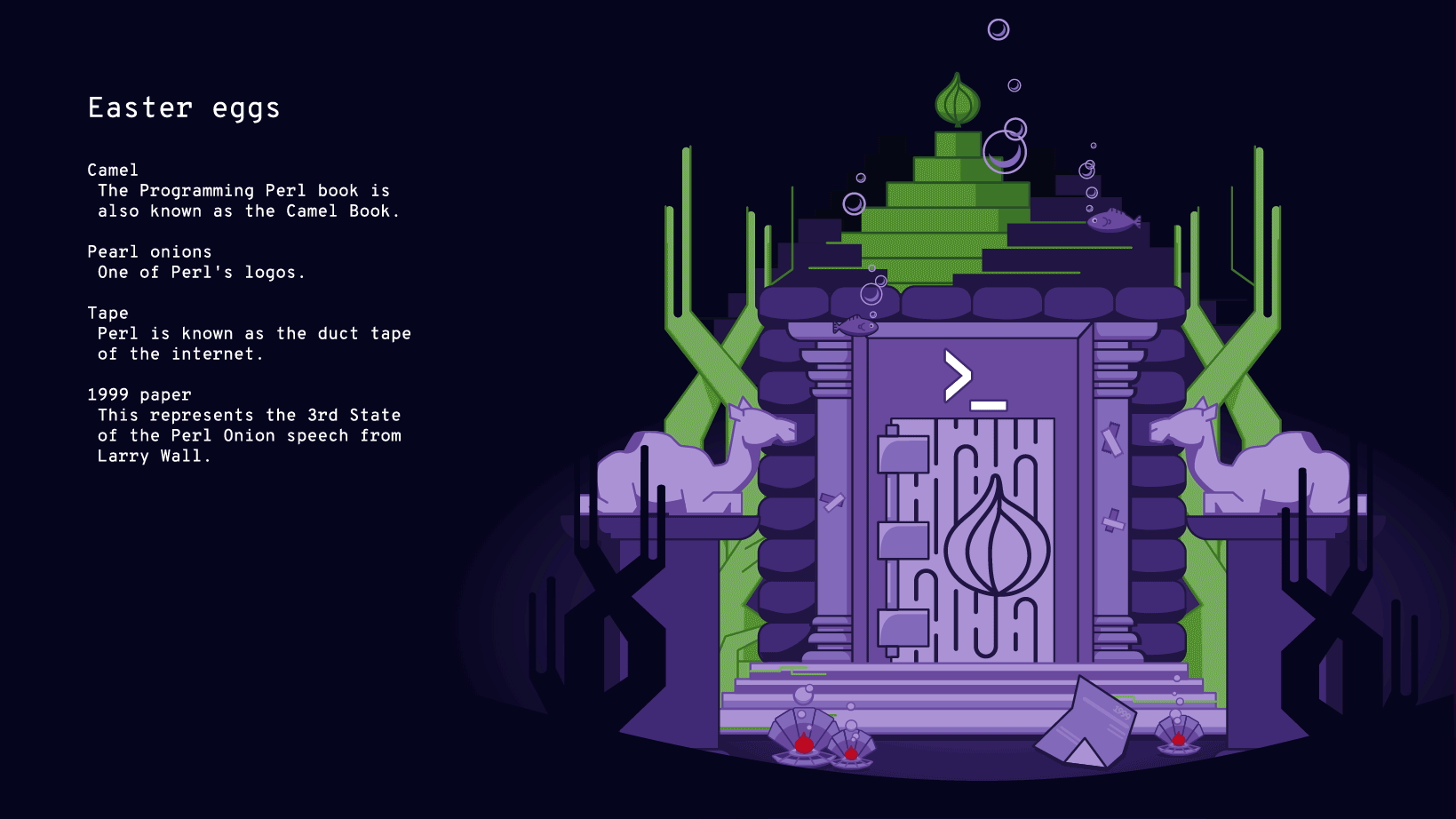Diving for Perl presented a unique challenge for us: how do we depict a language that was once one of the most popular in programming, without then implying it’s unwanted or in ruins? We wanted to tell Perl’s story while also staying true to its current status—a powerful language with an active community.
What was your research process for uncovering the history of Perl?
Karen Crowson, Designer: I didn’t do much research into Perl’s actual source code, but took a lot from its visuals and its history. We placed this one in the water because of the name of the episode: Diving for Perl. But that’s not what we started with. Our first idea was to have it in a jungle, inspired by the lost cities of Cambodia. We wanted to allude to something that had its heyday, but then fell from prominence. But we wanted to make sure that it didn't look like ruins—because this is a language that is still used today and loved. That’s when we decided to lean more on the title’s pun instead.
What was your biggest influence for this episode’s art?
Karen: Perl’s own visuals played a part. We pay homage to both Perl logos: the onion and the camels.
Johan Philippine, Copywriter: Playing around with the idea of a pearl was especially helpful, and along with the title led us to the underwater setting. We struggled a bit with the decision to placing it underwater, since episode four’s “land” is on the arrow section of the Command Line Heroes logo—out of the water. Would we move it and change the path to one of the water points, then go back to land for the next episode? We decided it wouldn’t be worth it, and to keep it where it was—especially since pearl diving happens in both fresh water and in coastal waters. We kept the ancient temple too, but in good condition—even if it is underwater.
What’s your favorite part of this episode’s art?
Karen: The fact that it’s underwater. It’s different than the rest, and it lent itself to some simple animations. I was also able to play around with how I placed the components, like the Perl onion as a pearl.
Was it immediately obvious how you’d animate this artwork?
Laura Walters, Animator: There was talk about how to move from land to sea in this episode, ultimately the best way I found to animate that was accentuating the plunge into the water, reflecting the episode title, “Diving for Perl”. We used lots of fun bubbles, fish drivebys, and some underwater caustics helped it feel more immersive.

Did it turn out how you expected?
Karen: It turned out to be better I think. Before it was on land. It wasn’t until it was revisited closer to the launch of the episode that we placed it underwater and we’re able to add in more elements.
We’re always happy when a good pun leads to good ideas. Diving for Perl’s artwork is available for download on the episode page. Next time, we’ll tell you all about the artwork for COBOL and Go, and the easter eggs hidden in our infrastructure.
저자 소개
유사한 검색 결과
채널별 검색
오토메이션
기술, 팀, 환경을 포괄하는 자동화 플랫폼에 대한 최신 정보
인공지능
고객이 어디서나 AI 워크로드를 실행할 수 있도록 지원하는 플랫폼 업데이트
클라우드 서비스
관리형 클라우드 서비스 포트폴리오에 대해 더 보기
보안
환경과 기술 전반에 걸쳐 리스크를 감소하는 방법에 대한 최신 정보
엣지 컴퓨팅
엣지에서의 운영을 단순화하는 플랫폼 업데이트
인프라
세계적으로 인정받은 기업용 Linux 플랫폼에 대한 최신 정보
애플리케이션
복잡한 애플리케이션에 대한 솔루션 더 보기
오리지널 쇼
엔터프라이즈 기술 분야의 제작자와 리더가 전하는 흥미로운 스토리
제품
- Red Hat Enterprise Linux
- Red Hat OpenShift Enterprise
- Red Hat Ansible Automation Platform
- 클라우드 서비스
- 모든 제품 보기
툴
체험, 구매 & 영업
커뮤니케이션
Red Hat 소개
Red Hat은 Linux, 클라우드, 컨테이너, 쿠버네티스 등을 포함한 글로벌 엔터프라이즈 오픈소스 솔루션 공급업체입니다. Red Hat은 코어 데이터센터에서 네트워크 엣지에 이르기까지 다양한 플랫폼과 환경에서 기업의 업무 편의성을 높여 주는 강화된 기능의 솔루션을 제공합니다.

